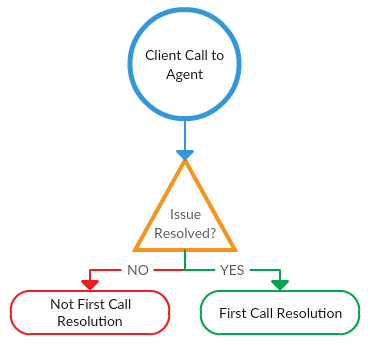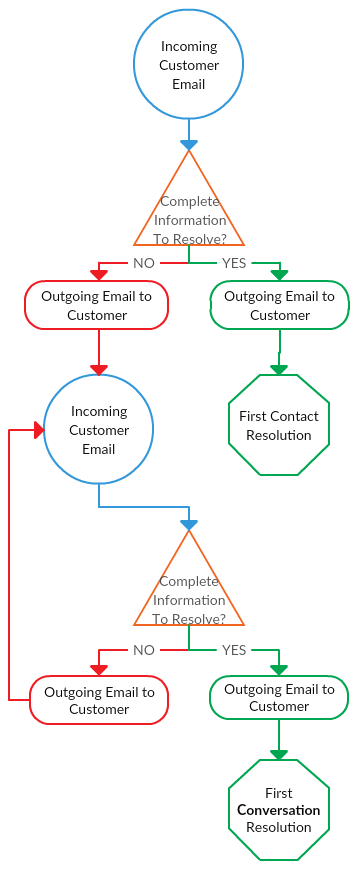Over the years customer support centers have evolved from being simple call centers with general support options to hosting specialized agents who focus on specific support functions to being even more complex contact centers with multiple channels for customers to connect with service agents. Contact centers have grown from offering support through phone calls only to include digital channels such as email, chat, and social media support options. With all these changes and new channels for support, the way agent effectiveness and customer satisfaction are measured has to evolve to keep up with how conversations happen.
FCR, traditionally defined as First Call Resolution, is one of the metrics whose definition has to evolve with the contact center and should continue to change as conversations become more complex. In the beginning, FCR was measured like this:

A customer calls for support. One agent receives the call. The agent either resolves the issue or she does not. If she did solve the problem, the FCR box gets checked on the ticket or customer survey. The box does not get checked if it was not resolved with that single call and the customer does not have to call back for the same issue. To remove one obstacle from the conversation, we will assume all check boxes are filled in by way of a customer survey. It will become clear why this concession is important shortly.
First Call Resolution works well in the above example because of its simplicity and binary definition. Many call center leaders would be excited if all tickets were this simple. According the 2015 HDI Support Center Practices & Salary Report more than 72 percent of support centers are able to get calls resolved on the initial customer call. Most call centers have escalation teams in place for more complex issues or when a customer is not happy with the resolution offered by the first agent they spoke to. This is where the simplest of FCR definitions begins to change. If a customer makes one phone call and the first agent needs to pass the call to another agent because the original agent lacks the needed skill set or level of empowerment to completely resolve the issue, but the next agent is able to resolve the issue, can the call be scored as a First Call Resolution?
For most leaders, the answer is no since two agents were involved in the call. The first agent did not completely resolve the issue so it cannot possibly be scored as FCR. Right? This is why leaders have to choose who checks the box for FCR. What if the issue was a level two technical support call and the customer called into the level one support line? The level one agent has to transfer the customer to the right leveled agent so the issued can be resolved. If the agent has to check the box, the call could not pass FCR since they did not resolve the issue on their own. If the customer checks the box, the pass-thru call could still be yes for FCR since their issue was resolved on the first call they made for the issue. This gives us the first change to consider for the definition of FCR, albeit an optional one based on if leadership is measuring agent effectiveness or the customer experience.
The next change to FCR happens when conversations with contact centers no longer involve phones. How can a metric with the word call be applied to a digital conversation where a customer never dials a number to call for support? Now FCR stands for First Conversation Resolution.
How can a metric with the word call be applied to a digital conversation where a customer never dials a number to call for support?
More often than not, the same rules from a phone call apply to a chat or digital conversation. That is to say, a customer starts one chat session and receives a response from one agent that completely resolves their issue. This makes a chat session the digital channel closest to a phone call. Both parties provide questions and answers in a nearly real-time, synchronized way, so the conversation flows as if the customer and agent were talking. Something the customer may not see is if the chat agent has to contact another team member for assistance on a complex issue, unless the other agent’s name appears in the chat dialog and takes over the conversation.
Email communication starts with the simple and binary measurement for FCR, regardless of who does the measuring: was the customer’s issue resolved in a single reply email? Yes or no. This scenario assumes the customer provided all the necessary information in their original email needed for the agent to provide the resolution. If the customer did not provide enough information for the responding agent to provide a clear and definitive answer in a single email reply, First Call Resolution may not be possible.
Email becomes the first channel to need a completely new definition of FCR: First Conversation Resolution. The change is necessary because of the asynchronous method of communication that email represents. Customers and agents are not able to ask questions during the same interaction so the conversation is drawn out over time by exchanging messages.

By accepting the new paradigm, leadership has to understand that individual email replies from agents cannot be viewed independently for monitoring purposes. Now entire conversation histories have to be considered to accurately measure FCR in terms of conversations versus calls or contacts. Agents may respond to a customer’s email in a fast and efficient time, but the customer might not respond as quickly. This part of the asynchronous conversation style represents a new challenge because conversations can overlap measuring periods for agents or teams. A customer may take several days or weeks to respond to an agent’s request for more information which impacts the ability to close out a ticket. If a ticket can’t be closed, then FCR by any definition cannot happen. One solution is to provide agents with a new resolution state. Now, tickets can be open, closed, or closed pending customer response. Leaders have to decide if a ticket that is pending a customer response can be marked as FCR or not.
Entire conversation histories have to be considered to accurately measure FCR.

If chat and email communication are not enough to require a deeper look at the definition of FCR, or how it is measured, add social media networks to the mix. Several different social media networks are open for customers to reach out for help. Some of the more popular in the United States include Facebook, Twitter, and Instagram. These networks have some similarities, such as the ability to post messages in public view or in private conversations, while they vary on the number of characters in a message and how each message is posted. Social media messages also resemble emails in that they are asynchronous and often require more than one message between customers and agents to get an issue resolved. A common social media customer support conversation on one network can go something like this:
- 12:00 p.m. Customer (Public Message): Hi CompanyX, I forgot my login to your website. Can you help?
- 12:02 p.m. Agent (Public Message): Hi Customer. I can try! Please send me a private message with your telephone number.
- 9:07 a.m. Customer (Private Message): My number is 555-555-5555. Why do you need to call me?
- 9:08 a.m. Agent (Private Message): Thanks. I need to speak with you to ID you with your account. Please stand by for my call.
- 9:15 a.m. [Agent calls Customer]
- 9:27 a.m. Agent (Public Message): Thanks, Customer, for taking my call. Please let me know if you have any further concerns. Have a great day!
We can assume the agent that called the customer was able to resolve the issue with the login in a timely manner since the time from the start of the call to the last public message was 12 minutes. What is not as clear is if that agent was the original agent who responded to the original customer message at 12:02 PM. Was the interaction resolved with a positive FCR? The customer might check the box for yes because they had a single conversation with an agent, albeit on two different channels. Then again, they might not because they could not get resolution in the channel of their choice. Leadership has the additional challenge of determining if the conversation can be checked as a yes even if there were two agents involved since the customer didn’t give a callback number until after the end of the original agent’s shift.
What happens to FCR if the customer reaches out on different social media networks, but all the networks are monitored by the same team or agent? Does one network get marked as passing FCR and the other one does not because the customer didn’t finish the conversation on the same network? What if a customer tries to resolve their issue by first going to a self-help forum or FAQ before calling the technical support line and sending a social media message while on hold?
These questions demonstrate how difficult contact center metrics can become when new channels are introduced into a service model. Each channel, be it phones, chat, email, social media, or support forums, exists to provide the best possible level of support for the customer. Business leaders have to decide how to measure success by creating and defining useful metrics like FCR. They have to also be agile enough to shift definitions to meet their needs and the needs of their teams. If an agent is unable to provide a positive FCR experience, but is held responsible for that result, make sure the definition of FCR matches the type of conversation flow that is happening. Take as much time to understand what is being measured as is taken to do the measuring.
Al Hopper has more than 20 years of customer service experience, including more than a decade in the contact center space and a term of service in the Army. He leveraged his MBA from the American Public University System to become cofounder of SocialPath Solutions. He is currently the Director of Operations building key processes and business relationships with clients to develop their social media customer service operations through consulting and hosted social media response teams. Follow Al on Twitter @AlHopper_ and connect with him on LinkedIn.